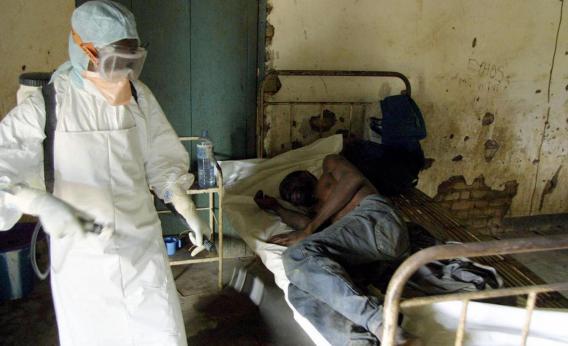I don’t remember where or when I contracted a deadly terror of the Ebola virus. But by fourteen or so I’d traded in my childish nightmares of the bubonic plague (thanks, History Channel) and rabies (thanks, Microbe Hunters) for Ebola. I’d wake up with a headache and wonder whether the infection was taking hold. A mild rash became the occasion for endless bargaining with God. The swirling dread of bioterrorism after Sept. 11 and the sense that, if one were to develop Ebola in some suburban pocket of Mainsville, America, no one would know how to respond, created—at least, to my mind—one of the most potent phantasms to stalk a childhood since the nuclear Armageddon.
So my inner hypochondriac teenager breathed a huge sigh of relief when I read this week that scientists had developed a cure for monkeys infected with the Ebola virus—and that “only a few steps” remain before that cure might be applied to humans. A clinical trial testing the treatment’s safety for humans is slated to begin before the end of 2014.
Ninety percent of people infected with Ebola, a hemorrhagic fever, die within 10 days. They experience massive internal bleeding as a protein fastened to the surface of the virus rips into their blood vessels’ endothelial linings, un-knitting all the body’s barrier systems and leaving any open spaces awash in blood. The virus first appeared in 1976 in the Democratic Republic of Congo and has since killed about 600 people. (The upside of the disease’s virulence is that it destroys its hosts too quickly to propagate very far).
As the news from Winnipeg broke at the Slate office and around the web, other Ebola-phobes emerged from the woodwork to dance on the grave of the boogeyman. “I remember reading ’The Hot Zone’ as a kid and Ebola became the mythical horror creature to me,” tweeted Atlantic’s Jared Keller. Slate Future Tense editor Torie Bosch also confessed to being haunted by Richard Preston’s 1994 novel, in which lethal strains of Ebola blaze through Sudan, Zaire, and finally a research facility in Reston, Va. Slate V producer Chris Wade declared the virus “the single most terrifying thing on the planet” and reminisced: “I can still vividly remember having to put The Hot Zone down after reading a description of the sound your liquefied guts make, violently hemorrhaging out of your orifices.” What sound was that? “It’s like ‘the tearing of bed sheets.’ ”
Somehow, my Ebola fear emerged without my ever having cracked The Hot Zone, so I pulled it up on Google Books. Loosely based on actual Ebola outbreaks in the late ’80s, Preston’s thriller dramatizes the lurid interior breakdown, the detonations of dark blood, that make the virus so appalling.
The red spots on the skin grow and spread and merge to become huge, spontaneous bruises, and the skin goes soft and pulpy, and can tear off if it is touched with any kind of pressure. Your mouth bleeds, and you bleed around your teeth, and you may have hemorrhages from the salivary glands—literally every opening in the body bleeds no matter how small. … The surface of the tongue turns brilliant red and then sloughs off, and…may be torn off during rushes of the black vomit. … Your heart bleeds into itself; the heart muscle softens and has hemorrhages into its chambers, and the blood squeezes out of the heart muscle as the heart beats…
The movie Outbreak, released in 1995, may also deserve some credit for our culture-wide contagion of Ebola dread.
So is it time to celebrate? And will the next generation of neurotic kids need a new loup-garou? Not so fast. As Dennis Burton, an immunologist at the Scripps Research Institute in La Jolla, Calif., explained to Nature on Wednesday, the Canadian antibodies work only when administered within one or two days of exposure. Once symptoms appear, he warns, “I would remain rather pessimistic given the explosive course of Ebola virus disease.”
Even worse, recent years have seen several other rosy reports of Ebola vaccines that work on monkeys—and so far, each has yielded anticlimactic results. In 2003, scientists at the Dale and Betty Bumpers Vaccine Research Center successfully immunized eight animals against the virus. And again in 2005, the journal Nature Medicine revealed that 12 macaques injected with an experimental vaccine also resisted infection. Similar success stories peppered the news cycle once more in spring 2010. But none of this research has yet translated into a viable human vaccine.
In horror movies, the cockeyed optimists always get picked off first. I’d be as thrilled as anyone to wave goodbye to the Ebola virus, but a teenaged voice in my ear is telling me to hedge my bets. Though the news coming from the National Microbiology Laboratory in Canada is encouraging, our fever hasn’t yet broken. Richard Preston help us: The nightmare lifts inch by inch but is not gone.
